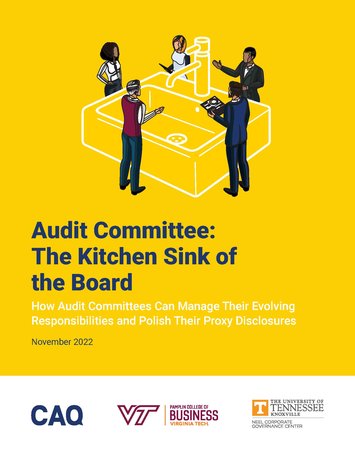The role of the audit committee has changed significantly since the passage of the Sarbanes-Oxley Act of 2002 (SOX), with many audit committees now overseeing a variety of emerging risks and balancing an ever-increasing workload. In seeking to understand more about audit committees’ evolving responsibilities, proxy disclosure strategies, and self-evaluation processes, the Center for Audit Quality partnered with academic researchers at the University of Tennessee Knoxville’s Neel Corporate Governance Center and the Pamplin College of Business at Virginia Tech who interviewed audit committee chairs or members from a variety of industries, company sizes, and maturity levels. To supplement the views of audit committees, the researchers also interviewed members of the investor community and those charged with preparing proxy disclosures to learn how audit committees can better communicate their oversight responsibilities.
Collectively from these interviews, the research team gleaned leading practices related to three questions of current interest to audit committees and their stakeholders that are discussed in this publication:
How can boards effectively allocate oversight responsibilities to the audit committee?
How can audit committee members keep up with an ever-evolving workload?
How can audit committees improve their disclosures related to audit committee oversight responsibilities?
Key Findings
Opportunities to Polish Audit Committee-Related Proxy Disclosures
Putting together everything the researchers learned during the interviews, the following areas have been identified as the greatest opportunities for enhanced audit committee disclosures.
- Clearly define the allocation of risk oversight for the overall board and the committees. Audit committees and investors both recognize that each board has a unique way of allocating risk oversight to the board overall and to the committees. In order for investors to assess whether the qualifications of the audit committee are appropriate, they first need to understand what risks are overseen by the audit committee.
- Explain why the audit committee members, individually and as a whole, are appropriate for this specific company. Investors and audit committee participants both see the benefit of clearly communicating who is on the audit committee and their qualifications. Companies can further improve this disclosure by telling a story to highlight how specific qualifications align with company-specific risks overseen by the audit committee.
- Highlight continuing education. Given that many audit committees believe that a key aspect of managing evolving responsibilities is continuing education and constantly learning new things, companies have the opportunity to showcase what audit committee directors are doing to stay up to date with current issues and evolving risk areas.
- Describe how the audit committee addresses key risks. Very few audit committees currently provide detailed disclosure of the key risks addressed by the audit committee, but this was one of the most frequently discussed issues with investors.
- Discuss more than just external audit oversight. Conversations with audit committee participants reveal that their jobs are much greater in scope than purely external auditor oversight. Thus, the disclosures should also provide a timely discussion of the expanded set of oversight responsibilities.
